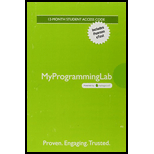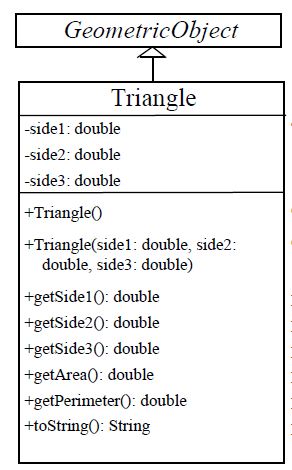
(Triangle class) Design a new Triangle class that extends the abstract GeometricObject class. Draw the UML diagram for the classes Triangle and GeometricObject then implement the Triangle class. Write a test
Program to create Triangle class
Program Plan:
- Include a class name named “Exercise_13_01”.
- Include the scanner package.
- Declare the main() function.
- Create a scanner object.
- Prompt the user to enter three sides of the triangle.
- Prompt the user to enter a color.
- Prompt the user to enter a Boolean value on whether the triangle is filled.
- Create triangle object with the entered user input.
- Set color and set filled in the triangle.
- Print the output.
- Close the main() function.
- Close the class “Exercise_13_01”.
- Include an abstract class “GeometricObject”.
- Declare all the data types of the variables.
- Construct a default geometric object.
- Construct a geometric object with color and filled value.
- Assign color and fill to the object.
- Set a new color.
- Define an isFilled method returns filled and since filled is Boolean; the get method is named isFilled.
- Set a new filled and getDateCreated method.
- Override toString function to return output.
- Define Abstract method getArea.
- Define Abstract method getPerimeter.
- Close class.
- Include a class “Triangle” that extends the class GeometricObject.
- Declare the three sides of the triangle.
- Include a triangle constructor.
- Assign values to all three sides of the triangle.
- Assign triangle values to all attributes.
- Return side1 and Set side1 to a new length.
- Return side2 and Set side2 to a new length.
- Return side3 and Set side3 to a new length.
- Create a Function to return area of the Triangle.
- Create a function to return a string description of the object.
- Close class.
The java code to design a new Triangle class that extends the abstract GeometricObject class and to design a test program that prompts the user to enter three sides of the triangle, a color, and a Boolean value to indicate whether the triangle is filled or not.
Explanation of Solution
Program:
File name: Exercise_13_01.java
//package to have user input
import java.util.Scanner;
//class Definition
public class Exercise_13_01
{
// Main method
public static void main(String[] args)
{
// Create a Scanner object
Scanner input = new Scanner(System.in);
/* Prompt the user to enter three sides of the triangle */
System.out.print("Enter three side of the triangle: ");
double side1 = input.nextDouble();
double side2 = input.nextDouble();
double side3 = input.nextDouble();
// Prompt the user to enter a color
System.out.print("Enter a color: ");
String color = input.next();
/*Prompt the user to enter a boolean value on whether the triangle is filled*/
System.out.print("Is the triangle filled (true / false)? ");
boolean filled = input.nextBoolean();
/* Create triangle object with the entered user input */
Triangle triangle = new Triangle(side1, side2, side3);
// set color
triangle.setColor(color);
// set filled
triangle.setFilled(filled);
// print the output
System.out.println(triangle.toString());
System.out.println("Area: " + triangle.getArea());
System.out.println("Perimeter: " + triangle.getPerimeter());
System.out.println("Color: " + triangle.getColor());
System.out.println("Triangle is" + (triangle.isFilled() ? "" : " not ")
+ "filled");
}
}
Filename: GeometricObject.java
//abstract class GeometricObject definition
public abstract class GeometricObject
{
//data type declaration
private String color = "while";
private boolean filled;
private java.util.Date dateCreated;
// Construct a default geometric object
protected GeometricObject()
{
dateCreated = new java.util.Date();
}
/* Construct a geometric object with color and filled value */
protected GeometricObject(String color, boolean filled)
{
dateCreated = new java.util.Date();
//assign color and fill
this.color = color;
this.filled = filled;
}
// Return color
public String getColor()
{
return color;
}
// Set a new color
public void setColor(String color)
{
this.color = color;
}
/* isFilled method returns filled and Since filled is boolean,the get method is named isFilled */
public boolean isFilled()
{
return filled;
}
// Set a new filled
public void setFilled(boolean filled)
{
this.filled = filled;
}
// Get dateCreated
public java.util.Date getDateCreated()
{
return dateCreated;
}
//override toString function to return output
@Override
public String toString()
{
return "created on " + dateCreated + "\ncolor: " + color +
" and filled: " + filled;
}
// define Abstract method getArea
public abstract double getArea();
//Define Abstract method getPerimeter
public abstract double getPerimeter();
}
Filename: Triangle.Java
/*Class definition of Triangle that extends the class GeometricObject */
public class Triangle extends GeometricObject
{
//declare the three sides of the triangle
private double side1;
private double side2;
private double side3;
//triangle constructor
public Triangle()
{
}
//assign values to all three sides of the triangle
public Triangle(double side1, double side2, double side3)
{
this.side1 = side1;
this.side2 = side2;
this.side3 = side3;
}
//assign triangle values to all attributes
public Triangle(double side1, double side2, double side3, String color, boolean filled)
{
this(side1, side2, side3);
setColor(color);
setFilled(filled);
}
// Return side1
public double getSide1()
{
return side1;
}
// Set side1 to a new length
public void setSide1(double side1)
{
this.side1 = side1;
}
// Return side2
public double getSide2()
{
return side2;
}
// Set side2 to a new length
public void setSide2(double side2)
{
this.side2 = side2;
}
// Return side3
public double getSide3()
{
return side3;
}
// Set side3 to a new length
public void setSide3(double side3)
{
this.side3 = side3;
}
// Function to Return area of the Triangle
@Override
public double getArea()
{
double s = (side1 + side2 + side3) / 2;
return Math.sqrt(s * (s - side1) * (s - side2) * (s - side3));
}
/* override function to Return perimeter of the triangle */
@Override
public double getPerimeter()
{
return side1 + side2 + side3;
}
/*override function to Return a string description of the object*/
@Override
public String toString()
{
return super.toString() + "\nArea: " + getArea() + "\nPerimeter: " + getPerimeter();
}
}
UML Diagram:

Explanation:
- Here, GeometricObject is an abstract class that extends the triangle class which is represented using an arrow. The triangle class then contains a rectangle that represents the objects used to input the three sides of the triangle.
- The remaining part is used to represent all the methods and functions used in the triangle class.
- The Triangle() method creates a triangle with default sides. The method Triangle(side1:double, side2; double,side3;double) creates a triangle of the specified sides.
- Then the respective sides of the triangles are returned using getSide() methods.
- Then the method getArea() returns the area of the triangle and the method getPerimeter() returns the perimeter of the triangle and the function toString() returns a string description of the object.
Enter three side of the triangle: 3
4
5
Enter a color: red
Is the triangle filled (true / false)? false
created on Sun Jul 08 13:24:03 IST 2018
color: red and filled: false
Area: 6.0
Perimeter: 12.0
Area: 6.0
Perimeter: 12.0
Color: red
Triangle is not filled
Want to see more full solutions like this?
Chapter 13 Solutions
MyLab Programming with Pearson eText -- Access Card -- for Introduction to Java Programming and Data Structures, Comprehensive Version
Additional Engineering Textbook Solutions
Elementary Surveying: An Introduction To Geomatics (15th Edition)
Modern Database Management
SURVEY OF OPERATING SYSTEMS
Starting Out with Java: From Control Structures through Objects (7th Edition) (What's New in Computer Science)
Computer Science: An Overview (13th Edition) (What's New in Computer Science)
Starting Out with C++ from Control Structures to Objects (9th Edition)
- Could you help me to know features of the following concepts: - commercial CA - memory integrity - WMI filterarrow_forwardBriefly describe the issues involved in using ATM technology in Local Area Networksarrow_forwardFor this question you will perform two levels of quicksort on an array containing these numbers: 59 41 61 73 43 57 50 13 96 88 42 77 27 95 32 89 In the first blank, enter the array contents after the top level partition. In the second blank, enter the array contents after one more partition of the left-hand subarray resulting from the first partition. In the third blank, enter the array contents after one more partition of the right-hand subarray resulting from the first partition. Print the numbers with a single space between them. Use the algorithm we covered in class, in which the first element of the subarray is the partition value. Question 1 options: Blank # 1 Blank # 2 Blank # 3arrow_forward
- 1. Transform the E-R diagram into a set of relations. Country_of Agent ID Agent H Holds Is_Reponsible_for Consignment Number $ Value May Contain Consignment Transports Container Destination Ф R Goes Off Container Number Size Vessel Voyage Registry Vessel ID Voyage_ID Tonnagearrow_forwardI want to solve 13.2 using matlab please helparrow_forwarda) Show a possible trace of the OSPF algorithm for computing the routing table in Router 2 forthis network.b) Show the messages used by RIP to compute routing tables.arrow_forward
- using r language to answer question 4 Question 4: Obtain a 95% standard normal bootstrap confidence interval, a 95% basic bootstrap confidence interval, and a percentile confidence interval for the ρb12 in Question 3.arrow_forwardusing r language to answer question 4. Question 4: Obtain a 95% standard normal bootstrap confidence interval, a 95% basic bootstrap confidence interval, and a percentile confidence interval for the ρb12 in Question 3.arrow_forwardusing r languagearrow_forward
- using r languagearrow_forwardusing r language Obtain a bootstrap t confidence interval estimate for the correlation statistic in Example 8.2 (law data in bootstrap).arrow_forwardusing r language Compute a jackknife estimate of the bias and the standard error of the correlation statistic in Example 8.2.arrow_forward
 EBK JAVA PROGRAMMINGComputer ScienceISBN:9781337671385Author:FARRELLPublisher:CENGAGE LEARNING - CONSIGNMENT
EBK JAVA PROGRAMMINGComputer ScienceISBN:9781337671385Author:FARRELLPublisher:CENGAGE LEARNING - CONSIGNMENT Microsoft Visual C#Computer ScienceISBN:9781337102100Author:Joyce, Farrell.Publisher:Cengage Learning,
Microsoft Visual C#Computer ScienceISBN:9781337102100Author:Joyce, Farrell.Publisher:Cengage Learning, C++ Programming: From Problem Analysis to Program...Computer ScienceISBN:9781337102087Author:D. S. MalikPublisher:Cengage Learning
C++ Programming: From Problem Analysis to Program...Computer ScienceISBN:9781337102087Author:D. S. MalikPublisher:Cengage Learning C++ for Engineers and ScientistsComputer ScienceISBN:9781133187844Author:Bronson, Gary J.Publisher:Course Technology PtrProgramming Logic & Design ComprehensiveComputer ScienceISBN:9781337669405Author:FARRELLPublisher:Cengage
C++ for Engineers and ScientistsComputer ScienceISBN:9781133187844Author:Bronson, Gary J.Publisher:Course Technology PtrProgramming Logic & Design ComprehensiveComputer ScienceISBN:9781337669405Author:FARRELLPublisher:Cengage Programming with Microsoft Visual Basic 2017Computer ScienceISBN:9781337102124Author:Diane ZakPublisher:Cengage Learning
Programming with Microsoft Visual Basic 2017Computer ScienceISBN:9781337102124Author:Diane ZakPublisher:Cengage Learning





